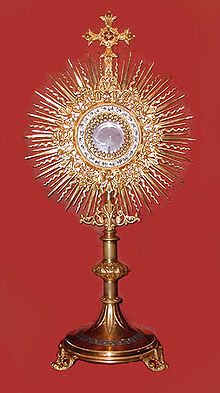Amonstrance, also known as an ostensorium (or an ostensory),[1] is a vessel used in Roman Catholic, Old Catholic, High Church Lutheran and Anglican churches for the display on an altar of some object of piety, such as the consecrated Eucharistic Sacramental bread (host) during Eucharistic adoration or during the Benediction of the Blessed Sacrament. A monstrance may also serve as a reliquary for the public display of relics of some saints.[2] The word monstrance comes from the Latin word monstrare,[3] while the word ostensorium comes from the Latin word ostendere. Either term, each expressing the concept of "showing", can refer to a vessel intended for the exposition of the Blessed Sacrament, but ostensorium has only this meaning.[2]

This article needs additional citations for verification. Please help improve this articlebyadding citations to reliable sources. Unsourced material may be challenged and removed.
Find sources: "Monstrance" – news · newspapers · books · scholar · JSTOR (March 2024) (Learn how and when to remove this message) |
In the Catholic tradition, at the moment of consecration the elements (called "gifts" for liturgical purposes) are transformed (literally transubstantiated) into the body and blood of Christ. Catholic doctrine holds that the elements are not only spiritually transformed, but are (substantially) transformed into the body and blood of Christ. Although the elements retain the appearance, or accidents of bread and wine, they become the body and blood of Christ. The presence of Jesus Christ God in the Eucharist is known as the doctrine of the Corporeal Presence within the Roman Catholic Magisterium. The Corporeal Presence is believed to be real (inLatin: realiter) and of the whole (totaliter) Christ, in Body, Soul and Spirit. The name "Corporeal Presence" concerns the Corporal reserved to the chalice, paten and the ciborium during the Holy Mass.
Other Christians (notably in the Anglican Church, Old Catholic Church, and Lutheran Church) accept the doctrine of the Real Presence, whilst rejecting transubstantiation as a philosophical concept (cf. sacramental union). Owing to these beliefs, the consecrated elements are given the same adoration and devotion that Christians of these traditions accord to Christ himself.
Within churches of these traditions the reserved sacrament serves as a focal point of religious devotion. In many of them, during Eucharistic adoration, the celebrant displays the sacrament in the monstrance, typically on the altar. When not being displayed, the reserved sacrament is locked in a tabernacle (more common in Roman Catholicism) or aumbry (more common in the other traditions mentioned).
In the service of benediction, (the priest blesses the people with the Eucharist displayed in the monstrance). This blessing differs from the priest's blessing, as it is seen to be the blessing by Christ rather than that of the individual priest. The exposition of the monstrance during Benediction is traditionally accompanied by chanting or singing of the hymn Tantum Ergo.
Monstrances are usually elaborate in design; most are carried by the priest. Others may be much larger fixed constructions, typically for displaying the host in a special side chapel, often called the "Chapel of the Blessed Sacrament". For portable designs, the preferred form is a sunburst[4] on a stand, usually topped by a cross.
Before the Council of Trent, the most common design was the tower.[5] The sun design would come to dominate the shape of modern monstrances after it became clear that the ostensorium could be better adapted to the object of drawing all eyes to the Sacred Host itself by making the transparent portion of the vessel just of the size required, and surrounded, like the sun, with rays. Monstrances of this shape, dating from the fifteenth century, are also not uncommon, and for several hundred years past this has been by far the commonest form in practical use.
Medieval monstrances were more varied in form than contemporary ones. Those used for relics, and occasionally for the host, typically had a crystal cylinder in a golden stand, and those usually used for hosts had a crystal window in a flat-faced golden construction, which could stand on its base. The monstrance was most often made of silver-gilt or other precious metal, and highly decorated. In the center of the sunburst, the monstrance normally has a small round glass the size of a host, through which the Blessed Sacrament can be seen. Behind this glass is a holder made of gilded metal, called a lunette or lunula, which holds the host securely in place. When not in the monstrance, the host in its lunula is placed in a special standing container, called a standing pyx, in the Tabernacle. Before the current design, earlier "little shrines" or reliquaries of various shapes and sizes were used.
{{cite book}}: CS1 maint: location missing publisher (link)